From 2025 to 2035, global Superconducting Magnets Market will grow markedly as they are used increasingly in fields like medical imaging, particle accelerators, fusion energy research, and industrial applications. Known for their high magnetic field strength and efficiency, superconducting magnets are widely used in MRI machines, nuclear fusion reactors, scientific institutes and the like.
But continuous improvement in cryogenic cooling operations, and the emergence of new materials like high-temperature superconductors (HTS) also means even wider markets. More investment in the health and energy sectors, and government support for research projects are helping to surge business opportunities in this company.
The market is projected to surpass USD 4,360.78 Million by 2035, growing at a CAGR of 2.3% during the forecast period.
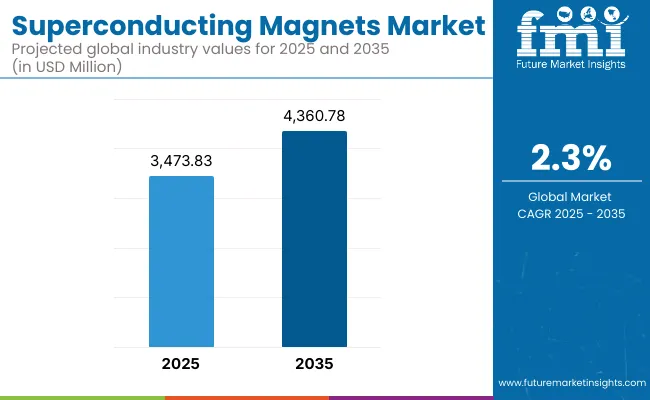
North America is the dominant force in superconducting magnets, its advanced medical imaging industry and avowed pursuit of fusion energy research. It has spent large amount for projects with magnetic confinement, such as nuclear fusion experiments. And has developed applications using magnetic confinement devices in high energy physics.
The United States plays a key role in this market, as the host to leading research institutions and medical facilities that’re increasingly adopting superconducting magnets. Government support for projects like improving the security of MRI systems and activities such as ITER give further momentum to the market. Through uninterrupted technological innovation and a relatively substantial industrial base, North America remains at the front line of rising superconducting magnetic technology.
Europe is an important player in superconducting magnets, where it has a large-scale research infrastructure and cooperates with the world in science and medicine. The founding of large projects such as CERN supplied with superconducting magnets to be used in particle accelerators to conduct cutting edge physics research, lays its claim as the top domain in the world.
Europe's development of renewable energy and sophisticated medical technologies both stimulate market enlargement. Across the continent, governments are funding fusion energy research, laying the foundation for next-generation applications of superconductivity. Ultimately, by sticking to industrialized society and latest medical developments, Europe continues to foster innovation and serve as a major hub for superconductivity matters.
Asia-Pacific, with a fast growing population and increasing incomes, has become the highest development area for superconducting magnets. Among Japanese companies, which have taken advantage of these developments even more vigorously than their European and American counterparts, Mitachi Corporation is a dominant player in medical imaging.
Japan also has extensive research in the field of superconducting applications, including its development of high-speed maglev trains. On the other hand, the Indian government is making big investments in superconductor research through institutions such as the Bose Institute to drive progress in high-speed superconducting materials. All of these things mean that Asia-Pacific will change global markets with its increasing investments and technological breakthroughs.
Challenge
High Production Costs
The development and production of superconducting magnets use such expensive materials as niobium-titanium or niobium-tin, multiplying their cost. With cryogenic cooling systems adding to overall complexity, production becomes a challenge for general use.
Operational Challenges and Maintenance
Superconducting magnets must be kept in a state of extremely low temperature if they are to remain superconducting. Effort and extra expense are involved in the design and procurement of highly efficient cooling systems which can ensure this. Even small temperature rises can send a magnet into quench, which in turn affects performance and adds to running costs.
Opportunity
Advancements in Superconducting Materials
Continual research into high-temperature superconductors (HTS) has driven the design of more efficient, cheaper superconducting magnets. The advent of second-generation (2G) HTS materials brings new opportunities for expanding their uses.
Expanding Applications across Industries
Superconducting magnets for medical imaging (MRI), particle accelerators, energy storage, and nuclear fusion research are on the rise. A large market for magnet fields in scientific and industrial use is an engine of growth.
Over the years 2020 to 2024, the adoption of superconducting magnets in medical imaging and particle physics research grew. Governments were supporting expensive fusion energy research programs, while the drive for more compact and energy-efficient MRI systems driven up demand.
The market will shift from mechanical cry cooling technology to all-electrical in the next decade. Resistance is the main issue, but as engineers have learned how to produce high-quality, low-resistance joints using state of the art laser welding equipment, this problem should be solved one innovation after another.
Market Shifts: A Comparative Analysis 2020 to 2024 vs. 2025 to 2035.
| Market Shift | 2020 to 2024 Trends |
|---|---|
| Regulatory Landscape | Standardized safety and performance regulations |
| Market Demand | Growth driven by MRI and particle accelerators |
| Industry Adoption | Early adoption of HTS materials |
| Supply Chain and Sourcing | Dependence on niobium-based materials |
| Market Competition | Dominated by established scientific institutions |
| Market Growth Drivers | Investment in medical imaging and research |
| Sustainability and Energy Efficiency | Focus on improving cryogenic cooling efficiency |
| Integration of Digital Innovations | Adoption of smart monitoring for magnet stability |
| Advancements in Product Design | Improvements in compact MRI designs |
| Market Shift | 2025 to 2035 Projections |
|---|---|
| Regulatory Landscape | Stricter environmental regulations for cryogenic materials |
| Market Demand | Expanding use in fusion energy and quantum computing |
| Industry Adoption | Widespread adoption of second-generation superconductors |
| Supply Chain and Sourcing | Increased availability of cost-effective HTS materials |
| Market Competition | Entry of new players from energy and healthcare industries |
| Market Growth Drivers | Innovations in renewable energy and quantum technology |
| Sustainability and Energy Efficiency | Transition to sustainable superconducting materials |
| Integration of Digital Innovations | AI-driven predictive maintenance and performance optimization |
| Advancements in Product Design | Development of superconducting energy storage systems |
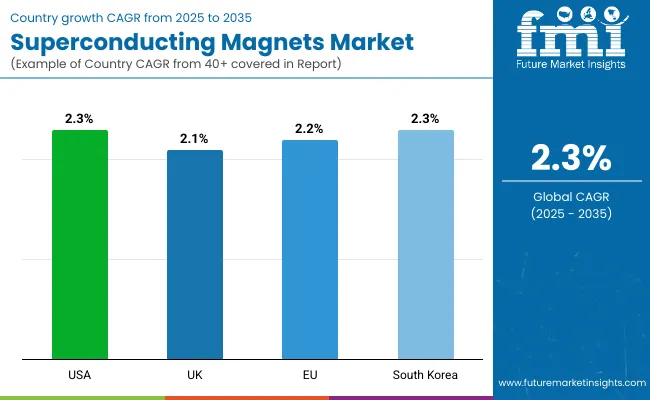
In the United States, the Superconducting Magnets Market enjoyed a strong growth in 2025 as demand for healthcare imaging equipment, sub-estron accelerators and power storage devices rose. This market can provide the large-scale medical physics center and particle accelerator which Fermi National Accelerator Laboratory needs; it also challenges such a demand for superconductors goes without mention but is in fact self-evident.
| Country | CAGR (2025 to 2035) |
|---|---|
| United States | 2.3% |
As advanced superconducting technologies are applied in research institutions and healthcare providers in the United Kingdom, its Superconducting Magnets Market is growing. There is increasing investment poured into fusion energy research large-scale applications at laboratory sites will also prompt for this market to expand further.
| Country | CAGR (2025 to 2035) |
|---|---|
| United Kingdom | 2.1% |
The European Union's superconducting magnet market is benefiting from research projects in high-energy physics and other new materials such as renewable energy storage and medical applications. Partly led by government initiatives and private sector investment, countries like Germany and France are at the forefront of developing superconductor technology.
| Country | CAGR (2025 to 2035) |
|---|---|
| European Union | 2.2% |
South Korea's Superconducting Magnets Market is gradually seeing expansion from the development of health care, scientific research and fusion energy projects. The government's encouragement of new-generation medical technology next step working together with international organizations on research have also played an important part in this steady growth.
| Country | CAGR (2025 to 2035) |
|---|---|
| South Korea | 2.3% |
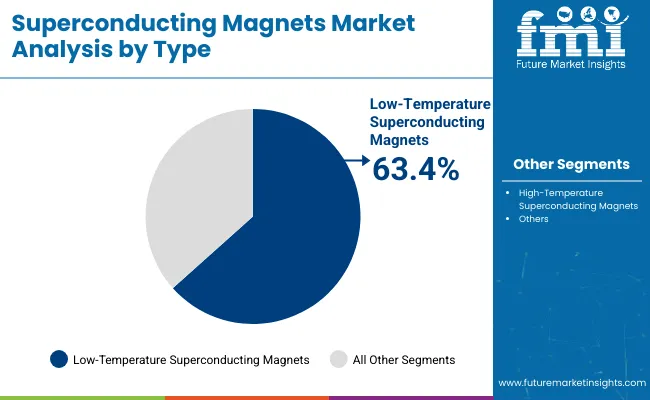
| Type | Market Share (2025) |
|---|---|
| Low-Temperature Superconducting Magnets | 63.4% |
By 2025 LTS magnets will still hold a dominant share of 63.4%. These products, which come in various shapes and sizes but all operate at an average temperature of below -250°C, currently are extensively used in MRI machines, particle accelerators with light ions, nuclear magnetic resonance spectroscopy (NMR) instruments, etc. On the other hand, their excellent ability to generate high magnetic field strengths with low need for resistance make them very useful tools for use both in medicine and some research fields.
Despite the increasing attention which today is being paid to HTS Magnets, LTS technology still reigns as a preferred choice because of its maturity, reliability, and cost effectiveness. Moreover, ongoing improvements in cryogenic cooling systems have helped to reduce running costs further favouring the dominance of cryogenic magnets.
As health care and scientific institutions continue to invest in the development of precision imaging as well as diagnostic tools, for decades to come the demand for LTS magnets is likely to remain strong so providing added impetus to further growth in the market over next few years.
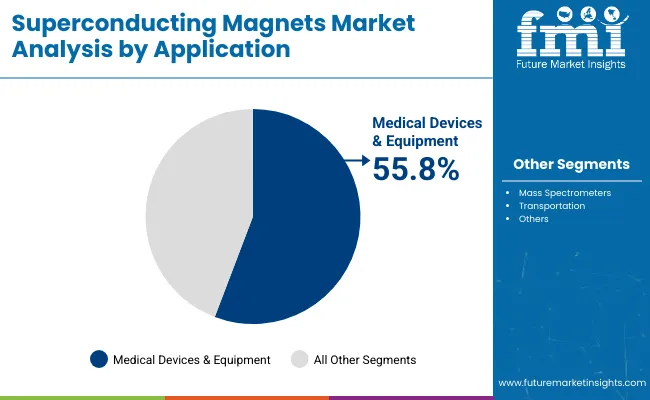
| Application | Market Share (2025) |
|---|---|
| Medical Devices & Equipment | 55.8% |
As the largest application segment of superconducting magnets market, medical devices and equipment is predicted to take up nearly 55.8% by 2025. The steady rise in global demand for MRI (Magnetic Resonance Imaging) machines is a major stimulus to business because these high-resolution diagnostic imaging systems incorporate superconducting magnets.
MRI has become the standard diagnostic tool for diseases of the nervous system, heart and blood vessels, bones and joints With the increase in chronic diseases, and the population age is becoming older, health care institutions are buying large amounts of advanced imaging solutions, thereby increasing demand for superconducting magnets.
Part of this trend is attributable to the aging demography, and increases in chronic diseases. In the face of such a demographic development, large imaging techniques are in demand along with superconducting magnets.
Higher education institutions are using NMR spectroscopy and superconducting magnet based diagnostic tools increasingly across this category. Customers are driving manufacturers to produce more efficient compact and low cost equipment because of the focus on higher resolution capability, greater patient throughput and lower operating costs.
Superconducting magnetics is a popular industry that has shown strong growth, driven by advances in medical imaging, particle accelerators and fusion energy research. Slang Content Metal Magnets DE super-conducting magnets or "low-temperature super magnets" are well known for being able to generate powerful magnetic fields without much energy wastage, and so they are applied wherever fluids might hinder such applications as MRI machines and others.
However, the widespread use of SCMs in aberrational atmospheres creates further problems for these machines. Way Forward Relevant enterprises are diversifying their investments today to obtain the next-generation superconducting material and cryogenic cooling system which at present limits the efficiency and application range of these technologies.
Market Share Analysis by Company
| Company Name | Estimated Market Share (%) |
|---|---|
| Siemens Healthineers | 18-22% |
| GE Healthcare | 15-19% |
| Philips Healthcare | 12-16% |
| Sumitomo Electric Industries | 10-14% |
| Oxford Instruments | 8-12% |
| Other Companies (combined) | 30-40% |
| Company Name | Key Offerings/Activities |
|---|---|
| Siemens Healthineers | In March 2024, launched an advanced high-field MRI system utilizing next-generation superconducting magnets. In January 2025, expanded production facilities for superconducting medical imaging solutions. |
| GE Healthcare | In April 2024, introduced an AI-enhanced superconducting magnet technology for improved diagnostic imaging. In February 2025, partnered with research institutes for fusion energy applications. |
| Philips Healthcare | In May 2024, unveiled a compact superconducting magnet for portable MRI systems. In March 2025, invested in cryogenic cooling innovations to enhance superconducting efficiency. |
| Sumitomo Electric Industries | In June 2024, developed high-temperature superconducting magnets for industrial and scientific applications. In February 2025, expanded its footprint in the fusion energy sector. |
| Oxford Instruments | In August 2024, launched a next-generation superconducting magnet for quantum computing research. In March 2025, partnered with universities to advance NMR spectroscopy technologies. |
Key Company Insights
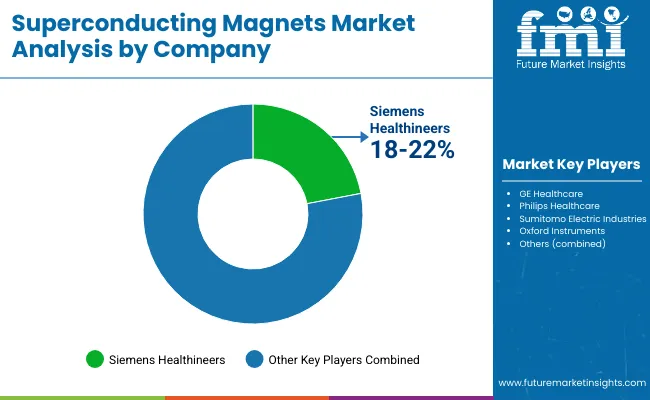
Siemens Healthineers (18-22%)
Siemens Healthineers leads the superconducting magnet sector, focusing on cutting-edge MRI technologies and expanding medical imaging capabilities.
GE Healthcare (15-19%)
GE Healthcare is investing in AI-driven superconducting magnet advancements, targeting medical and research applications.
Philips Healthcare (12-16%)
Philips is developing compact and portable superconducting magnets, making MRI technology more accessible and efficient.
Sumitomo Electric Industries (10-14%
Sumitomo specializes in high-temperature superconducting solutions, expanding its reach into industrial and fusion energy applications.
Oxford Instruments (8-12%)
Oxford Instruments is pioneering superconducting magnet technologies for quantum computing and advanced spectroscopy applications.
Other Key Players (30-40% Combined)
The overall market size for Superconducting Magnets market was USD 3,473.83 Million in 2025.
The Superconducting Magnets market is expected to reach USD 4,360.78 Million in 2035.
The demand for superconducting magnets will be driven by advancements in medical imaging, fusion energy research, high-speed transportation, and increasing applications in mass spectrometry, supported by government investments and technological innovations.
The top 5 countries which drives the development of Superconducting Magnets market are USA, European Union, Japan, South Korea and UK.
Low-Temperature Superconducting Magnets demand supplier to command significant share over the assessment period.






Full Research Suite comprises of:
Market outlook & trends analysis
Interviews & case studies
Strategic recommendations
Vendor profiles & capabilities analysis
5-year forecasts
8 regions and 60+ country-level data splits
Market segment data splits
12 months of continuous data updates
DELIVERED AS:
PDF EXCEL ONLINE
Superconducting Detector Market Size and Share Forecast Outlook 2025 to 2035
Superconducting Quantum Chip Market Size and Share Forecast Outlook 2025 to 2035
Superconducting Materials Market Size and Share Forecast Outlook 2025 to 2035
Superconducting Wire Market

Thank you!
You will receive an email from our Business Development Manager. Please be sure to check your SPAM/JUNK folder too.
Chat With
MaRIA